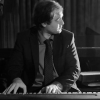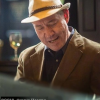Home » Jazz Articles » Live Review » Sun Ra Arkestra at Great American Music Hall
Sun Ra Arkestra at Great American Music Hall
SFJAZZ Center
San Francisco, California
February 6-8, 2024
Over the decades, music venues in San Francisco have come and gone, but one constant remains: Great American Music Hall. A house of ill repute when it first opened in 1907, the building has gone through several transitions as a musical performance space and has even served the Loyal Order of the Moose as a meeting hall. In 1972, visionary Tom Bradshaw refurbished and repainted it, reincarnating the building as Great American Music Hall. The list of just a few of the artists presented reads like a "Who's Who" of jazz and includes artists such as Cal Tjader, Sarah Vaughan, Carmen McRae, Stan Getz, Mongo Santamaria, Dizzy Gillespie, Herbie Mann, Bill Evans and Buddy Rich. Later on, jazz (and other artists) recorded live dates here. For example, McCoy Tyner recorded The Greeting (Milestone, 1978) here during three mid-March 1978 evenings. In later years, the venue featured ensembles such as the World Saxophone Quartet and even featured a duet between Don Cherry and Billy Higgins, and Roscoe Mitchell played there as well. The hall has even hosted acts such as Van Morrison.
While programming had shifted in recent years, the Hall's booking of the Sun Ra Arkestra for three nights is an encouraging sign for local jazz patrons. No American cultural institution is quite like the Arkestra. The sound and infectious merriment this band creates onstage produces a blend of rapturous physical and sonic color, light, textures and tapestries. The reflective garb of the band's shiny garments blends seamlessly with the gleam of their brass horns. The sound ranges from free jazz cacophony to extended polyrhythmic percussion jams; there is always movement and always a jubilant spirit. And a team spirit as well, gained through the school of hard knocks. Because life for band members has not always been a smooth ride.
This musical brew was the creation of one individual. Born Herman Blount, Sun Ra (1914-1993) was an Alabama-born pianist, synthesizer player, composer and bandleader who iconoclastically maintained that he was from Saturn. Ra had a core, highly dedicated following of acolyte musicians who resided communally in Germantown, a neighborhood of Philadelphia. Recently the subject of a fascinating feature story in The Guardian, near-centenarian saxophonist Marshall Allen still resides there. Allen replaced groundbreaking saxophonist John Gilmore as bandleader following Gilmore's ascension. Ra's mentor was the groundbreaking big band leader Fletcher Henderson for whom he arranged compositions while both were in Chicago. There is no question that Ra was ahead of his era. He began using a Moog synthesizer in the 1970s, and his touring band would project films that would play as they marched around the room playing instruments. The orchestra has re-blossomed in the past few years, producing new CDs and touring extensively. The fact that most of the musicians have stuck around for decades, some until their deaths, implies a lot about how camaraderie and shared experience have unified band members.
Allen, who joined the band in 1957, no longer tours, and Knoel Scott has proven to be an emphatic and skilled replacement. Scott, who recently recorded a disc with Allen, is an expert saxophonist, dancer, crooner and emcee who can switch from sax to conga and back again—all while conducting the band—with ease. On Wednesday evening he shared a poem onstage from "Sun Ra Collected Works Volume 1" with us. He was happy to share anecdotes about the history of the band, talking about things such as "John Gilmore's seat." He clearly holds the band's patrimony dear. As longtime vocalist Tara Middleton, could not make these dates, Allen shared the vocal chores with personable trumpeter Cecil Brooks, who also proved to be an ebullient force of nature.
Pianist Farid Barron also had plenty of onstage visbility. Mentored by Wynton Marsalis, Barron joined the Arkestra in 2006 after exiting the Air Force. Barron banged a huge gong set atop his piano at times, danced around the stage, played a lot of rollicking piano, and conjured some wonderfully suitable Ra-like tones with his synthesizer. Looking down from Saturn, Ra must have been delighted.
Seated at his customary position in the front of the stage, Marin resident Kash Killion held forth on his cello and sarangi, as he has in performance and recording since 1989. Real chemistry was evident in the way he and Scott communicated, almost a call and response between Scott's gesticulating fingers and Killion's on his bow. The other musicians were quieter, standing to blow out impressive solos as did trumpeter Michael Ray, a longtime member who regularly performs with Kool and the Gang, along with the other saxophonists and a trombonist. It was always a treat to see saxophonist Chris Hemingway stand up and play his transformative tenor and soprano solos.
Though the three evenings had separate titles—"Big Bang Swing," "Outer Space Jazz" and "The "World is Not a Ghetto"—many of the same compositions were overlapped each night. Key differences were that, whereas on the first night, the band played straight through, the second night had a 40-minute break between two sets. Because the horn section had a gig with Yo La Tengo at the Fillmore, the final evening had a slightly shortened set, the band omitting their colorful and boisterous characteristic parade around the venue with instruments in hand.
The majority of the tunes the Arkestra played were Sun Ra compositions. "Space is the Place," a show staple that is almost a theme song, ended most evenings, while the classic chestnut "We Travel the Spaceways" would start the show off. "We travel (We travel, we travel)/The spaceways (The spaceways, the spaceways)/From planet (From planet to planet)."
Scott conducted another classic, "Rocket #9," with characteristic gusto and aplomb. As is typical with Ra tunes, its lyrics are uncomplicated and fun: "Rocket Number Nine take off for the planet/To the planet, Venus/Zoom, zoom, zoom, zoom up in the air/Up, zoom, up, zoom, up in the air." And then there is "Seductive Fantasy" with its wild lyrics:
Are you the color of fog?
Are you the color of sound?
Are you the color of thought, singularity, sight simularity?
Tell me, what color are you?
Arkestra members have also produced some gems. For example, the unforgettable "Two Tone," composed by the late members, saxophonists Charles Davis and Pat Patrick and performed Wednesday night, featured Scott with fellow baritone saxophonist James Stewart, who joined the band in 2011), in a duet. Another, the frequently featured "Angels and Demons at Play, " was penned by the late bassist Ronnie Boykins.
The band has a special spot in their heart for classics. "Queer Notions," a Coleman Hawkins classic first recorded by Ra's beloved Henderson, was one of these. Scott would regularly introduce a blues number, maintaining that "This always was a Chicago blues band," before a stellar solo on acoustic bass by Tyler Mitchell started the piece off. "Holiday for Strings" was another. The Arkestra rendered it with lovely piano and thumping bass.
As the Arkestra left the stage at the end of every evening's performance with house lights still dimmed, the entranced audience would chant "We Travel the Spaceways" over and over. Then, the lights would come up and the spell broke. Don't miss a future chance to be similarly entranced, should the opportunity present itself.
Tags
Live Review
Sun Ra Arkestra
Harry S. Pariser
United States
California
san francisco
Cal Tjader
Sarah Vaughan
Carmen McRae
Stan Getz
Mongo Santamaria
Dizzy Gillespie
Herbie Mann
Bill Evans
Buddy Rich
McCoy Tyner
Don Cherry
Billy Higgins
Roscoe Mitchell
Van Morrison
Sun Ra
Marshall Allen
John Gilmore
Fletcher Henderson
Tara Middleton
Fahid Barron
wynton marsalis
Kash Killian
Michael Ray
Kool and the Gang
Chris Hemingway
Yo La Tengo
James Stewart
Charles Davis
Pat Patrick
Ronnie Boykins
Coleman Hawkins
Tyler Mitchell
David Rose
About Sun Ra Arkestra
Instrument: Band / ensemble / orchestra
PREVIOUS / NEXT
Support All About Jazz
 All About Jazz has been a pillar of jazz since 1995, championing it as an art form and, more importantly, supporting the musicians who make it. Our enduring commitment has made "AAJ" one of the most culturally important websites of its kind, read by hundreds of thousands of fans, musicians and industry figures every month.
All About Jazz has been a pillar of jazz since 1995, championing it as an art form and, more importantly, supporting the musicians who make it. Our enduring commitment has made "AAJ" one of the most culturally important websites of its kind, read by hundreds of thousands of fans, musicians and industry figures every month.






























